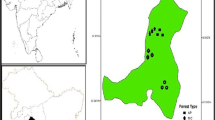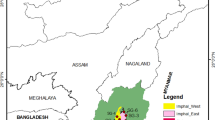Abstract
Soil profile CO2 transport and production are vital in the carbon stock in desert artificial vegetation ecosystem. In this study, soil profile CO2 concentration, soil water content, and temperature at depths of 0–40 cm were measured at four revegetated sites (1956, 1964, 1981, and 1987), located in the southeastern edge of Tengger Desert, China. The gradient method was applied to simulate soil gas diffusion coefficient and soil profile CO2 efflux. Soil CO2 efflux and production were significantly higher in upper layers than in bottom layers. The soil profile CO2 concentration, CO2 efflux, and production were not significantly increased with revegetation age. The simulated soil surface CO2 efflux were 0.54, 0.49, 0.44, and 0.25 μmol·m−2·s−1 at 1956, 1964, 1981, and 1987 revegetated sites, respectively. The soil surface CO2 efflux mainly came from the 0–10 cm layers, contributing to 76.4–94.9% of the total. CO2 uptake occurred in the 10–35 cm soil layer. Structural equation modelling explained 97.0% of the variations in soil surface CO2 efflux. The effects of soil CO2 concentration, temperature, and water content in the 10-cm layer and plant properties on soil surface CO2 efflux were 0.977, 0.516, − 0.358, and − 0.156, respectively. Interaction between soil temperature and water content was significant and the value was 0.439, indicating that the soil temperature and water content significantly influenced soil CO2 efflux. These results indicated that revegetation would not significantly affect the soil surface CO2 efflux and provided some theoretical basis for the study of soil carbon cycle mechanism in desert artificial vegetation ecosystem.






Similar content being viewed by others
Data availability
If some readers need our data, they can contact us directly, and we are glad to provide data for them to promote academic communication.
References
Allen MR, Frame DJ, Huntingford C et al (2009) Warming caused by cumulative carbon emissions towards the trillionth tone. Nature 458:1163–1166
Bond-Lamberty B, Thomson A (2010) Temperature-associated increases in the global soil respiration record. Nature 464:579-U132
Chamizo S, Rodriguez-Caballero E, Sanchez-Canete EP et al (2021) Temporal dynamics of dryland soil CO2 efflux using high-frequency measurements: patterns and dominant drivers among biocrust types, vegetation and bare soil. Geoderma 405:1–8
Curiel Yuste J, Janssens IA, Carrara A et al (2003) Interactive effects of temperature and precipitation on soil respiration in a temperate maritime pine forest [J]. Tree Physiol 23:1263–1270
Ding LP, Zhou QM, Wei JC (2013) Estimation of Endocarpon pusillum Hedwig carbon budget in the Tengger Desert based on its photosynthetic rate. Sci China Life Sci 56:848–855
Fa KY, Zhang YQ, Lei GC et al (2018) Underestimation of soil respiration in a desert ecosystem. CATENA 162:23–28
Fan Y, Chen JQ, Shirkey G et al (2016) Applications of structural equation modeling (SEM) in ecological studies: an updated review. Ecol Process 5:1–12
Fearnehough W, Fullen MA, Mitchell DJ et al (1998) Aeolian deposition and its effect on soil and vegetation changes on stabilised desert dunes in northern China. Geomorphology 23:171–182
Fierer N, Chadwick OA, Trumbore SE (2005) Production of CO2 in soil profiles of a California annual grassland. Ecosystems 8:412–429
Hao WL, Li BB, Xia B et al (2022) Deep carbon dioxide flows substantially contributes to soil-atmosphere carbon flux from Robinia pseudoacacia forests. Ecol Ind 141:1–14
Hosea MK, Makmom AA, Aris ZA et al (2016) Comparison of soil CO2 efflux in tropical forests of different ages, Peninsular Malaysia. Int J Agric for Plantation 2:130–145
Huang L, Zhang ZS, Hu YG et al (2014a) Soil CO2 concentration under different types of plant communities and the driving factors in arid desert area. J Desert Res 34:125–132
Huang L, Zhang ZS, Li XR (2014b) Soil CO2 concentration in biological soil crusts and its driving factors in a revegetated area of the Tengger Desert, Northern China. Environ Earth Sci 72:767–777
Jobbagy EG, Jackson RB (2000) The vertical distribution of soil organic carbon and its relation to climate and vegetation. Ecol Appl 10:423–436
Kuzyakov Y (2006) Sources of CO2 efflux from soil and review of partitioning methods. Soil Biol Biochem 38:425–448
Li XR, He MZ, Duan ZH et al (2007) Recovery of topsoil physicochemical properties in revegetated sites in the sand-burial ecosystems of the Tengger Desert, northern China. Geomorphology 88:254–265
Li XR, He MZ, Zerbe S et al (2010) Micro-geomorphology determines community structure of biological soil crusts at small scales. Earth Surf Proc Land 35:932–940
Li SL, Bowker MA, Xiao B (2021) Biocrusts enhance non-rainfall water deposition and alter its distribution in dryland soils. J Hydrol 595:1–13
Liang N, Hirano T, Zheng ZM et al (2010) Soil CO2 efflux of a larch forest in northern Japan. Biogeosciences 7:3447–3457
Ma J, Liu R, Li Y (2017) Abiotic contribution to total soil CO2 flux across a broad range of land-cover types in a desert region. J Arid Land 9:13–26
Maier M, Schack-Kirchner H (2014a) Using the gradient method to determine soil gas flux: a review. Agric for Meteorol 192–193:78–95
Maier M, Schack-Kirchner H (2014b) Reply to comment on “Using the gradient method to determine soil gas flux: a review.” Agric for Meteorol 197:256–257
Massman WJ (1997) A review of the molecular diffusivities of H2O, CO2, CH4, CO, O3, SO2, NH3, N2O, NO, and NO2 in air, O2 and N2 near STP. Atmos Environ 32:1111–1127
Min K, Berhe AA, Khoi CM et al (2020) Differential effects of wetting and drying on soil CO2 concentration and flux in near-surface vs. deep soil layers. Biogeochemistry 148:255–269
Moldrup P, Olesen T, Gamst J et al (2000) Predicting the gas diffusion coefficient in repacked soil: water-induced linear reduction model. Soil Sci Soc Am J 64:1588–1594
Moldrup P, Deepagoda TKKC, Hamamoto S et al (2013) Structure-dependent water-induced linear reduction model for predicting gas diffusivity and tortuosity in repacked and intact soil. Vadose Zone J 12:1–11
Nan WG, Yue SC, Li SQ et al (2016) The factors related to carbon dioxide effluxes and production in the soil profiles of rain-fed maize fields. Agric Ecosyst Environ 216:177–187
Pritchard DT, Currie JA (1982) Diffusion of coefficients of carbon dioxide, nitrous oxide, ethylene and ethane in air and their measurement. J Soil Sci 33:175–184
Raich JW, Tufekcioglu A (2000) Vegetation and soil respiration: correlations and controls. Biogeochemistry 48:71–90
Rey A (2015) Mind the gap: non-biological processes contributing to soil CO2 efflux. Glob Change Biol 21:1752–1761
Reynolds JF, Stafford Smith DM, Lambin EF et al (2007) Global desertification: building a science for dryland development. Science 316:847–851
Sánchez-Canete EP, Kowalski AS (2014) Comment on “Using the gradient method to determine soil gas flux: a review” by M. Maier and H. Schack-Kirchner. Agric for Meteorol 197:254–255
Schlesinger WH, Andrews JA (2000) Soil respiration and the global carbon cycle. Biogeochemistry 48:7–20
Su YG, Wu L, Zhang YM (2012) Characteristics of carbon flux in two biologically crusted soils in the Gurbantunggut Desert, Northwestern China. CATENA 96:41–48
Su YG, Li XR, Chen YW et al (2013) Carbon fixation of cyanobacterial-algal crusts after desert fixation and its implication to soil organic carbon accumulation in desert. Land Degrad Dev 24:342–349
Sun JY, Li XR (2021) Role of shrubs in the community assembly of biocrusts: the biotic and abiotic influences along a biocrust succession gradient. Plant Soil 460:163–176
Sun FH, Xiao B, Li SL et al (2021) Towards moss biocrust effects on surface soil water holding capacity: soil water retention curve analysis and modeling. Geoderma 399:1–11
Walvoord MA, Striegl RG (2006) CO2 dynamics in the Amargosa Desert: fluxes and isotopic speciation in a deep unsaturated zone. Water Resour Res 41:1–15
Wang B, Zha TS, Jia X et al (2013) Soil moisture modifies the response of soil respiration to temperature in a desert shrub ecosystem. Biogeosciences 10:9213–9242
Wang B, Zha TS, Jia X et al (2014) Soil moisture modifies the response of soil respiration to temperature in a desert shrub ecosystem. Biogeosciences 11:259–268
Wang YY, Li XX, Dong WX et al (2018) Depth-dependent greenhouse gas production and consumption in an upland cropping system in northern China. Geoderma 319:100–112
Wang ZY, Xie JB, Wang YG et al (2020) Biotic and abiotic contribution to diurnal soil CO2 fluxes from saline/alkaline soils [J]. Sci Rep 10:1–10
Wang B, Liu J, Zhang X et al (2021) Changes in soil carbon sequestration and emission in different succession stages of biological soil crusts in a sand-binding area. Carbon Balance Manag 16:1–12
Wordell-Dietrich P, Wotte A, Rethemeyer J et al (2020) Vertical partitioning of CO2 production in a forest soil. Biogeosciences 17:6341–6356
Xiao B, Hu K (2017) Moss-dominated biocrusts decrease soil moisture and result in the degradation of artificially planted shrubs under semiarid climate. Geoderma 291:47–54
Xie T, Shi WL, Yang HT et al (2023) Variations in organic carbon mineralization of the biological soil crusts following revegetation in the Tengger Desert, North China. CATENA 222:1–12
Yu YX, Zhao CY, Jia HT et al (2017) Effects of nitrogen fertilizer, soil temperature and moisture on the soilsurface CO2 efflux and production in an oasis cotton field in arid northwestern China. Geoderma 308:93–103
Zhang ZS, Li XR, Nowak RS et al (2013) Effect of sand-stabilizing shrubs on soil respiration in a temperate desert. Plant Soil 367:449–463
Zhang ZS, Dong XJ, Xu BX et al (2015) Soil respiration sensitivities to water and temperature in a revegetated desert. J Geophys Res Biogeosci 120:773–787
Zhao XN, Zhao CY, Stahr K et al (2020) The effect of microorganisms on soil carbonate recrystallization and abiotic CO2 uptake of soil. CATENA 192:1–7
Zhou LX, Fu SL, Ding MM et al (2012) Soil CO2 concentration and efflux from three forests in subtropical China. Soil Res 50:328–336
Funding
This work was supported by Chinese National Natural Scientific Foundation (41977420) and Key Research and Development Program of Ningxia Hui Autonomous Region (no. 2021BEG02009).
Author information
Authors and Affiliations
Contributions
All authors contributed to the study conception and design. Material preparation, data collection and analysis were performed by NY and HL. The first draft of the manuscript was written by NY and all authors commented on previous versions of the manuscript. All authors read and approved the final manuscript.
Corresponding author
Ethics declarations
Conflict of interest
The authors have no relevant financial or non-financial interests to disclose.
Additional information
Publisher's Note
Springer Nature remains neutral with regard to jurisdictional claims in published maps and institutional affiliations.
Rights and permissions
Springer Nature or its licensor (e.g. a society or other partner) holds exclusive rights to this article under a publishing agreement with the author(s) or other rightsholder(s); author self-archiving of the accepted manuscript version of this article is solely governed by the terms of such publishing agreement and applicable law.
About this article
Cite this article
Nan, Y., Huang, L., Yang, Y. et al. Evaluation of soil CO2 efflux and its influence factors in a revegetated area in Tengger Desert, NW China. Environ Earth Sci 82, 472 (2023). https://doi.org/10.1007/s12665-023-11152-2
Received:
Accepted:
Published:
DOI: https://doi.org/10.1007/s12665-023-11152-2




